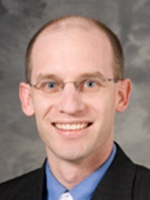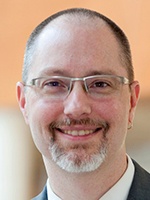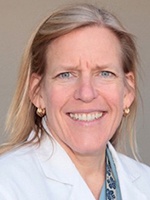Summary:
With physician leadership as a guiding force, many forward-thinking organizations are addressing burnout as more than a personal challenge for practitioners.
With physician leadership as a guiding force, many forward-thinking organizations are addressing the issue as something more than a personal challenge for practitioners.
When he’s on vacation, even when he’s relaxing on a Caribbean beach, Brian Arndt, MD, routinely taps into electronic health records on his laptop.
The demands of professional life are always with him — and have been for years.
“When I was younger, I’d see my dad with his black briefcase and his manila folders. He was an executive in manufacturing. It was always clear when he was working,” says Arndt, who directs a family medicine residency practice and is an associate professor at the University of Wisconsin School of Medicine and Public Health in Madison.

Brian Arndt
Arndt acknowledges that when work and home lives overlap, there’s a high potential for burnout to take root. He’s the lead author of a recent study, “Tethered to the EHR: Primary Care Physician Workload Assessment Using EHR Event Log Data and Time-Motion Observations,” that was published in the September/October 2017 issue of Annals of Family Medicine.
The report shows primary care physicians devote more than half of their workday, almost six hours, to EHR tasks during and after clinic hours. These obligations contribute to work-life imbalance, dissatisfaction, high rates of attrition, and a burnout rate around 50 percent, the authors note.
Fortunately, however, physician leaders and organizations are making strides toward combating the causes of burnout and embracing wellness. Some innovative programs, initiatives and techniques — from revamping documentation practices to providing peer support — are beginning to make an impact.
“Burnout is a prevalent issue,” says Colin P. West, MD, PhD, FACP, a professor of medicine, medical education and biostatistics and co-director of the program on physician well-being at Mayo Clinic in Rochester, Minnesota. “Solutions are going to require both individuals and organizations to work together, because this is a shared responsibility.”
From an individual standpoint, helpful initiatives have included resilience training, stress-reduction approaches, and “participation in physician group activities that help build a sense of community and meaning,” says West, an internist and lead author of “Interventions to Prevent and Reduce Physician Burnout: A Systematic Review and Meta-Analysis,” published in The Lancet in September 2016.

Colin West
“Further research is needed to establish which interventions are most effective in specific populations, as well as how individual and organizational solutions might be combined to deliver even greater improvements in physician well-being than those achieved with individual solutions,” the authors write. However, they add that “sustainability of intervention effects is poorly understood as few studies have assessed long-term burnout outcomes.”
Organizational Efforts
Burnout no longer is viewed solely as a detriment to physicians’ personal and professional lives; it’s being seen as something that affects the entire health care industry. Indeed, in 2016, then-U.S. Surgeon General Vivek Murthy said, “If health care providers aren't well, it's hard for them to heal the people for whom they are caring.”
Health care leaders have a vested interest in stemming a correlation between burnout and poor outcomes for patients, says Marc Moss, MD, a pulmonary and critical care specialist and vice chair of clinical research at the University of Colorado School of Medicine. However, he cautions, awareness is still in its relative infancy. During training, physicians sometimes depersonalize their feelings of exhaustion and develop ways of downplaying them, and “some of the coping mechanisms that are either taught or are implicit need to change,” Moss says.
Burnout is believed to be under-recognized and under-reported. It affects more than 60 percent of family practice providers and at least one-third of gastroenterologists, according to a report published online last June in Clinical Gastroenterology and Hepatology.
That mirrors the findings of the 2017 Medscape Lifestyle Report, which ranked physician burnout by specialty based on a survey of 14,000 physicians. Family medicine was among 12 specialties with a prevalence of more than 50 percent. Gastroenterology was among 12 specialties with a prevalence of more than 40 percent.
The CGH article, which presents a case study of an anonymous physician in distress, outlines a treatment program:
“Risk factors for burnout include being an early career physician, performing complicated procedures, work-life conflict [her spouse, whom she rarely sees, is a physician; she missed her daughter’s birthday], concerns over an impending deadline, and loss of control regarding her clinic schedule,” the authors write. During her first 15 months on faculty, the physician had taken only three vacation days while “pushing herself to meet increasing productivity targets despite an intentional reduction in her clinical schedule during her first year of a new job,” they continue. “After her grant is completed, she vows to schedule a weeklong vacation to spend some much-needed time with her family and to set limits at work to maximize time at home with her family.”
Brian E. Lacy, PhD, MD, lead author of the article, “Physician Burnout: The Hidden Health Care Crisis,” says the pressures experienced by this physician echo the sentiments that many others feel. Mental exhaustion can lead to the need to go on disability — temporarily or permanently.
“In many parts of the country, where we don’t have enough physicians, the last thing you want is somebody being over-burdened and retiring because now we’ve really made things worse,” says Lacy, a professor of medicine and chief of the section of gastroenterology and hepatology at Dartmouth-Hitchcock Medical Center in Lebanon, New Hampshire.
Integrating, Not Balancing
Krista L. Kaups, MD, MSc, FACS, who has participated in research on interventional efforts through the American College of Surgeons, suspects the personality traits that many surgeons share — a highly developed sense of responsibility, commitment and perfectionism — compel them to neglect their own needs.
“Their identity becomes entirely tied in with being a surgeon,” says Kaups, a professor of clinical surgery at the University of California at San Francisco’s Fresno campus and program director of surgical critical care at Community Regional Medical Center in Fresno.

Krista L. Kaups
Sleep and regular exercise fall by the wayside, and some surgeons may forgo annual checkups. “Self-care isn’t selfish,” she points out, while offering some direct advice: “You should have a physician, and it should not be yourself.”
However, instead of the emphasis on work-life balance, Kaups suggests the focus should be on “work-life integration,” which involves identifying the parts of a physician’s job that bring the most joy and make less desirable functions more tolerable. Research shows that spending as little as 20 percent of time at work on rewarding activities lessens the likelihood of burnout. For one person, a positive aspect could be research; for another, it could be mentoring younger colleagues.
Bellin Health, a community-based system in northeastern Wisconsin and Michigan’s Upper Peninsula, is developing an advanced team-based care model to address the matter, says Jim Jerzak, MD, a family physician in the Green Bay, Wisconsin, area who is leading the effort.
Research shows a major stressor is the rigorous requirements of EHR documentation, particularly during patient appointments. “That is the exact equivalent of texting while driving,” he says. “You’re not going to do either one well when you’re trying to do them together like that.”
Compounding that are the swelling complexities of patient care, as the aging population continues to grow and the incidence of diabetes and other lifelong conditions creeps upward. “We are in an epidemic of chronic disease, and that is very demanding on physicians,” Jerzak says.
To lessen the burden, Bellin is deploying an extended care team of case managers, clinical pharmacists, registered nurse coordinators and other health care professionals to help physicians manage high-risk patients. And in many cases, certified medical assistants and licensed practical nurses are tasked with closing care gaps, such as scheduling colonoscopies and administering immunizations. They also assist with documentation, freeing physicians to interact more with patients, he says.
“The redesigned system has eased the burnout issue and will keep me and, hopefully, many others working longer,” says Jerzak, who has been in practice since finishing his residency in 1986 and has no plans to retire in the foreseeable future. “It’s that comprehensive approach that is working to make the practice of medicine rewarding and enjoyable again.”
Fixing Inefficiencies
At Atrius Health in Newton, Massachusetts, an information technology “SWAT team” has been working on EHR performance. Atrius invested resources into improving work flow, recognizing that inefficiency plays a significant role in physician burnout. Once the new model is fully deployed, the system hopes to eliminate between 1 million and 1.5 million clicks annually for its practitioners, says Steven Strongwater, MD, president and chief executive officer.
His team also is devising strategies to deal with the overwhelming demands of email. “Many messages pour into the inbox, and we have found a number of ways to triage messages that people can work on them without involving physicians, looking at software that can automate some of the responses,” says Strongwater, who practiced rheumatology for about 25 years before moving into medical administration.
This spring, Atrius plans a two-day rejuvenation re-treat for its physicians and advanced practice clinicians. The health system has collaborated with the medical director of Canyon Ranch in Lenox, Massachusetts, a personal wellness resort. A series of lectures will emphasize nutrition, exercise and fitness, proper rest and mindfulness as they relate to wellness for health practitioners.
As part of their benefits package, Atrius employees get reimbursement and time off allocated toward continuing education credits, so interested clinicians can participate in this program without any additional cost to the organization.
The goal is to determine whether this experience will leave lasting impressions on attendees. “You need to measure over time people’s resilience and joy, and we do that on a quarterly basis,” Strongwater says. “At this time, we haven’t moved the needle as much as we would like.”
In January 2017, Duval County Medical Society in Jacksonville, Florida, launched a physician wellness program intended to address the seriousness of physician burnout in the community. The society’s members now have access to a 24-hour confidential wellness line and online direct access as well as six free counseling and coaching sessions with a psychologist.
In renewing licenses, physicians are typically asked whether they have ever seen a mental health practitioner or taken antidepressants. That’s why some physicians are reluctant to reach out for help and might resort to self-medicating, says Bryan Campbell, the medical society’s chief executive officer.
“In many ways, it’s harder for a physician to seek mental health counseling,” he adds. The program is predicated on the concept that “a healthy physician in a good state of mind is going to provide better care.”
Financial Ramifications
Stanford University School of Medicine launched its WellMD Center in 2016 to engage stakeholders in efforts to create a culture that prioritizes wellness. It aims to work with administrative leaders to relieve some of the strain on physicians by enhancing efficiency and streamlining workplace systems, including electronic health records, says Mickey Todd Trockel, MD, PhD, director of scholarship and health promotion.
“We are espousing focus on organizational factors — culture of wellness and efficiency of practice — rather than relying solely on cultivation of physicians’ own personal resilience,” he says. “Our model is comprised of two-thirds organizational factors.”
In addition to correlating with better outcomes for patients, Trockel cites “emerging evidence to demonstrate that there may be financial ramifications” for organizations’ attitudes toward physician wellness. Doctors who feel a sense of professional fulfillment rather than suffering from burnout are less likely to cut back on their clinical work time. They also might be less likely to leave their organizations, which, in turn, benefit from having less turnover, he says.
A peer support program can help clinicians through the heightened stress and vulnerability that often follow adverse clinical events, particularly medical errors. After such situations, clinicians often experience heightened feelings of fear, isolation and even burnout, says Jo Shapiro, MD, FACS, director of The Center for Professionalism and Peer Support at Brigham and Women’s Hospital and an associate professor of otolaryngology at Harvard Medical School in Massachusetts.
In the past decade, the hospital has trained more than 70 peer supporters. Shapiro matches the clinician with an appropriate peer supporter, typically pairing physicians with physicians and nurses with nurses, but not necessarily in the same specialty. The peer supporter speaks with the clinician via telephone or in person, whichever mode is the peer’s choice. Most peers prefer the phone option, and the supporter also follows up via email a week later to find out how the peer is feeling.
“Qualitatively, we’ve gotten incredibly positive feedback from the clinicians who have been supported,” says Shapiro, who is seeking approval from the hospital’s Institutional Review Board for a formal survey. “They have responded that the program has given them perspective and helped them feel less alone.”
Susan Kreimer is a freelance health care journalist based in New York.
Topics
Collaborative Function
Communication Strategies
Systems Awareness
Related
The Pandemic Proved That Remote Leadership WorksAmid Plummeting Diversity at Medical Schools, a Warning of DEI Crackdown’s ‘Chilling Effect’10 Signs of a Toxic Boss — and How to Protect YourselfRecommended Reading
Strategy and Innovation
The Pandemic Proved That Remote Leadership Works
Strategy and Innovation
Amid Plummeting Diversity at Medical Schools, a Warning of DEI Crackdown’s ‘Chilling Effect’
Team Building and Teamwork
10 Signs of a Toxic Boss — and How to Protect Yourself
Team Building and Teamwork
The Power of Hidden Teams
Operations and Policy
Artificial Intelligence in Healthcare: Legal Issues
Operations and Policy
How to Build Your Own AI Assistant
